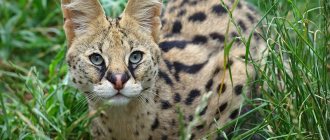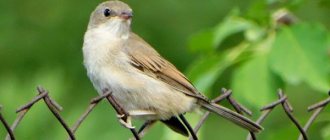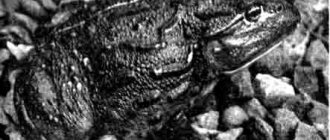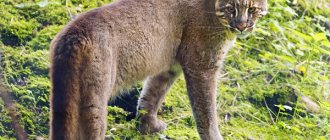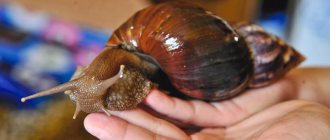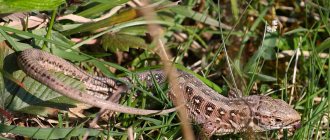Origin of the species and description
Photo: Black-footed cat
Black-footed cats are found only in three countries in southern Africa:
- Botswana;
- Namibia;
- South Africa.
These cats are found primarily in short to medium-length plains, scrub desert, and sandy plains, including the Kalahari and Karoo deserts. Areas of grass with high densities of rodents and birds provide optimal habitat. They seem to avoid bushes and rocky areas, possibly due to the appearance of other predators. The average annual precipitation in the region is 100-500 mm.
Video: Black-footed cat
The black-footed cat is quite rare compared to other small cats in South Africa. Knowledge of the behavior and ecology of this cat is based on many years of research at the Benfontein Game Reserve and two large farms in central South Africa. Researchers on the Black-footed Cat Working Group continue to study cats in these three areas.
Black-footed cats share their range with other predators - the African wildcat, Cape foxes, long-eared foxes and black-backed jackals. They hunt on average less prey than African wild steppe cats, although both catch about the same number (12-13) of prey species per night. Cats coexist with jackals (cat predators), using burrows during the day. They share space with Cape foxes, but do not use the same habitats, active times, or hunt the same types of prey.
Photo gallery: wild African black-footed cat
A black-footed cat can catch a bird when it flies low above him.
Blackfoot hiding in the bush
A black-footed cat in captivity retains its wild character. The black-footed cat mercilessly expels strangers from its territory. At the slightest danger, the kittens hide and wait for their mother. In the summer, the black-footed cat has a very bright and contrasting color.
The black-footed cat sleeps curled up in a ball, like most representatives of the cat tribe
The dry desert regions of Africa are the natural habitat of black-footed cats.
The black-footed African wild cat looks unusually sweet, but in this case, appearances are extremely deceptive. The little animal is a desperate and brave hunter who needs to live only in natural habitats, that is where he will be most comfortable.
History of the discovery of the species
Scientists do not know when these animals appeared in the fauna of our planet. The species first received a scientific description only in 1824, and the name “black-footed” does not entirely correspond to the truth. The animal is coal-colored only on its very feet, like many representatives of the cat family, in particular the wild African big cat. In addition, these two subspecies share a common natural habitat, so the animals are often confused.
The Black-footed or Small-spotted Cat (small spotted cat) is usually called the Ant Tiger by the local population due to its tendency to establish its shelters in abandoned termite mounds and burrows left by porcupines, rabbits, aardvarks, and long-legged animals. The bright coloring also matches the name.
Story
It is not known for certain how long these cats have existed; historical chronicles do not keep any records about them. But the breed was first described in 1824. The scientific species name is Felis nigripes (lat.). The animal was named black-footed because of the characteristic coloring of its limbs, which in fact are not completely black. Only the lower parts of the paws (feet), including the pads, have this color.
In fact, the cat’s legs are not black, the lower surfaces of the paws and pads are that color.
Another cat species has a similar color - Felis silvestris cafra (wild African big cat), which also has a similar habitat. There is some confusion here; in the English-language scientific literature, the black-footed cat is called the Small-spotted Cat.
Unofficially, these rare predators are called ant tigers. This may be because they like to make their lairs in empty termite mounds and abandoned old burrows of porcupines, rabbits, aardvarks and striders. And the coloration of the cats resembles the king of beasts.
Appearance and features
Photo: What a black-footed cat looks like
Native to the grasslands of southern Africa, the black-footed cat has a remarkably round face and a light brown body with black spots that is small even compared to domestic cats.
The black-footed cat's fur is yellowish-brown and marked with black and brown spots that merge into broad stripes on the neck, paws, and tail. The tail is relatively short, comprising less than 40% of the length of the head, and is marked with a black tip. The black-footed cat's head is similar to that of domestic cats, with large ears and eyes. The chin and throat are white, with distinct dark throat stripes and a black-tipped tail. The auditory convexities are increased in total length to about 25% of the length of the skull. Males are heavier than females.
Interesting fact: The difference between black-footed cats and other cats is that they are poor climbers and are not interested in tree branches. The reason is that their stocky bodies and short tails make climbing trees difficult.
These cats get all the moisture they need from their prey, but also drink water when it is available. Black-footed cats are known for their courage and tenacity. The black-footed cat's vision is six times better than that of humans, aided by its extremely large eyes. They are also equipped with excellent night vision and impeccable hearing, capable of picking up even the tiniest sound.
The wild cat is only 36 to 52 cm long, about 20 cm tall and weighs 1 to 3 kg, according to the International Endangered Cat Society. Admittedly, these measurements don't seem very impressive compared to big cats, which are some of the world's most formidable predators. But despite its small size, the black-footed cat hunts and kills more prey in one night than a leopard does in six months.
Mr. Cat recommends: description, characteristics, habitat
Felis nigripes - Black-footed cat or Ant Tiger - one of the smallest cats in the world along with the Asian rusty cat.
The main characteristics of the Ant Tiger include the following:
- Miniature sizes - weight about one and a half kilograms, in large males up to two and a half, body length from 35 to 55 cm, tail 10-20 cm.
- A large and beautiful head that does not violate the proportions of the body.
- Round and very large eyes that glow at night. In these animals, the retina is entangled in a vascular network, which causes phosphorescence. It is the tapetum that is responsible for the function of night vision, the increase in visual ability at this time of day and the bluish fluorescence of the retina.
- Large, high-set ears with a rounded tip.
- Strongly built body with an athletic build.
- Strong, but short limbs with a dense fleecy covering of the soles of the paws, protecting the animal from the hot surface of the sand. The pads are jet black in color and have fully retractable claws.
- The tail is medium length with a black tip and similar ring markings.
- Dense and thick wool, which has almost zero thermal conductivity. It is this structure of the fur that allows the cat not to overheat in the heat and not freeze at night, because temperature changes in the desert are great.
- The color is mainly sandy yellow with bright black markings.
- The ability to make peculiar ringing and loud sounds.
Since the beginning of this century, black-footed cats have been classified as a vulnerable species of animals; they are listed in the international Red Book and the second appendix of the CITES Convention on Trade in Wild Animals.
The main natural habitat of the miniature predator is the desert areas of the southern zones of the African continent. This is the Kalahari Desert, located in the lands of Namibia and Botswana, the southernmost points of Angola.
The animals also feel comfortable in flat areas with tough bushes, in semi-dried grass in the lands of Angola, the Republic of South Africa and Zimbabwe. They can also live on mountainous hills located up to two thousand meters above sea level.
In the scientific classification, the Ant Tiger subspecies is distinguished:
- Felis nigripes nigripes lives mainly in Namibia;
- Felis nigripes thomasi is more common in Botswana.
The color may vary slightly between varieties; the Namibian subspecies has a peach background, and the Botswana subspecies has a dark chocolate background.
Chaotically located marks are unique for each animal and are never repeated twice; this color serves as camouflage during night hunting. Usually the darkest part is the head, and the lightest part is the abdominal region, chest and inner surface of the legs.
Where does the black-footed cat live?
Photo: African black-footed cat
The black-footed cat is endemic to southern Africa and is found mainly in South Africa and Namibia, where it is equally rare. But also found in Botswana, in minor quantities in Zimbabwe and possibly minorly in southern Angola. The northernmost records are about 19 degrees south in Namibia and Botswana. It is therefore a restricted range species with the smallest distribution among cats in Africa.
The black-footed cat is a specialist in grassland and semi-desert habitats, including arid open savannah with sufficient numbers of small rodents and birds to inhabit the soil and sufficient cover for hunting. It is primarily found in arid areas and prefers open, sparsely vegetated habitats such as open savannas, grasslands, Karoo and Kalahari regions with sparse shrub and tree cover and an average annual rainfall of 100 to 500 mm. They live at altitudes from 0 to 2000 m.
Black-footed cats are nocturnal inhabitants of the arid lands of southern Africa and are typically associated with open, sandy, grassy habitats. Although little has been studied in the wild, optimal habitat appears to be savannah areas with tall grass and high densities of rodents and birds. During the day, they live in abandoned burrows dug or in holes in termite mounds.
Over the course of a year, males will travel up to 14 km, while females will travel up to 7 km. A male's territory overlaps that of one to four females. These desert dwellers are difficult to keep in captivity outside their native range. They have very specific habitat requirements and must live in dry conditions. At the Wuppertal Zoo in Germany, however, excellent progress has been made and the bulk of the population is in captivity.
Now you know where the black-footed cat lives. Let's see what she eats.
Description, lifestyle and habitat in the wild
The black-footed cat has fur of a rich sandy-yellow color, strewn with medium-sized black spots that can join into small stripes. The animal’s paws are strong and colored black, which is how this species of feline got its name.
Spotting greatly helps the African wild cat to hunt, successfully hiding it among the sands and stones of the desert savannah. This predator is characterized by the usual rhythm of life for this type of animal, which is characterized by hibernation on hot days and activity at night. If we talk about their habitat, the black-footed cat has chosen only the climate of arid Africa .
Did you know? A black-footed cat can go without water for about three days! Thanks to this striking feature, it is comfortable living in the dry areas of the Kalahari Desert.
Their population is so small that their area of residence is limited to several countries, and even then not in full, but only in sparsely populated areas. So, these animals are most often found in Zimbabwe and South Africa. They can be seen much less often in Botswana and Namibia. These predators settle in desert places where there are no people. The best shelter for them: a plain with sparse bushes and low-growing vegetation, where, thanks to the color of their fur, they will be self-confident.
Life in captivity
Despite their unsociable and harsh disposition, black-footed cats easily adapt to captivity. Although there are not many of these rare animals in zoos around the world - no more than five dozen adult individuals. If in natural conditions the life expectancy of an African cat does not exceed thirteen years, then in well-fed and calm conditions of captivity it lives longer - up to sixteen years.
The wild African cat adapts well to captivity conditions
Character and behavior
As in their natural habitat, in captivity these animals are nocturnal, and during daylight hours they sleep, trying to avoid being seen by people. Perhaps that is why many zoos are not very eager to replenish their collections with representatives of this rare and expensive species - the cost of one individual starts from ten thousand dollars. And visitors may never notice the small black-footed cat emerging from its hiding place only at dusk.
What does a black-footed cat eat?
Photo: Wild black-footed cat
The black-footed cat has a wide diet, and more than 50 different species of its prey have been identified. It hunts mainly rodents, small birds (about 100 g) and invertebrates. The animal eats mainly small mammals such as mice and gerbils. Its prey typically weighs less than 30-40 g, and it captures about 10-14 small rodents per night.
Occasionally, the black-footed cat will also feed on reptiles and larger prey such as bustards (such as the black bustard) and hares. When they hunt these larger species, they hide some of their prey, for example in hollows, for later consumption. The black-footed cat also preys on emerging termites, captures larger winged insects such as grasshoppers, and has been observed feeding on the eggs of black bustards and larks. Black-footed cats are also known as scavengers.
One adaptation to dry conditions allows the blackfooted cat to obtain all the moisture it needs from its food. In terms of interspecific competition, the black-footed cat takes, on average, less prey than the African wildcat.
Black-footed cats use three very different methods to catch their prey:
- the first method is known as "fast hunting", in which cats quickly and "almost casually" jump through tall grass to catch small prey such as birds or rodents;
- the second of their methods takes them on a slower course through their habitat as the cats wait quietly and warily to sneak up on potential prey;
- finally, they use the “sit and wait” method near the rodent burrow, a technique also called hunting.
Fun fact: In one night, a black-footed cat will kill 10 to 14 rodents or small birds, averaging a kill every 50 minutes. With a success rate of 60%, black-footed cats are approximately three times more successful than lions, resulting in an average kill success rate of approximately 20-25% of the time.
Can a savage become a pet?
Before you decide to own a black-footed cat at home, you need to familiarize yourself with information about the characteristics of this breed and weigh the pros and cons. The ant tiger is an absolute, wild predator. And even life among people (in a house/apartment) is unlikely to change the habits and habits of an animal. Therefore, the owners of such a pet need to be prepared for a real hurricane to settle in their home.
The black-footed cat, just as it does not like the presence of strangers on its territory in the wild, will not tolerate proximity to other animals in the house. Exceptions may be made in cases where both animals grew up together from a very tender age. However, even in this situation, the possibility cannot be ruled out that in the future the black-footed beast will not begin to show its character and demonstrate who is boss in the house.
A black-footed cat will not be able to live in an apartment. Her life as a pet can only be comfortable in a private house with a large local area. The best option is to build an enclosure outside.
It should contain a large number of ladders and various wooden crossbars necessary for the animal to crawl along them, and bushes - a favorite place for rest. Enclosures should be large enough for the cat to feel comfortable in them and not feel enclosed.
In the cat’s natural habitat – deserts, the ambient temperature ranges from +22° to +27°C. This temperature must also be maintained in the enclosure.
The diet of the domestic black-footed cat includes:
- lean varieties of meat, strictly fresh and high quality;
- chicken offal;
- cartilage and bones, sinewy parts - they contain many nutrients that are essential for the normal development of the animal’s jaw bones;
- dairy products with minimal or medium fat content;
- fresh fish.
To maintain the cat’s natural instincts, it needs to be periodically pampered with live food, introducing small rodents, mice, guinea pigs, and rats into the enclosure. Caring for a black-footed cat as a pet requires regular visits to the veterinarian and vaccinations.
Features of character and lifestyle
Photo: Black-footed cat from Africa
Black-footed cats are primarily land dwellers. They are nocturnal and solitary animals, with the exception of females with dependent cubs, and also during the mating season. They are active most of the night and travel an average of 8.4 km in search of food. During the day they are rarely seen, as they lie on rocky crevices or near abandoned burrows of spring hares, ground squirrels or porcupines.
Fun Fact: In some areas, black-footed cats use hollowed-out dead termite mounds, a termite colony that gives the animals the name "anthill tigers."
Household sizes vary between regions depending on available resources and are quite large for a small cat with an average size of 8.6-10 km² for females and 16.1-21.3 km² for males. Male households overlap with 1-4 females, and intrasexual households occur at the outer boundaries between resident males (3%), but average 40% between females. Males and females spray scent and thereby leave their mark, especially during the mating season.
The black-footed cat stalks its prey on the ground or waits at the entrance to a rodent burrow. It can catch birds in the air as they take off, as it is an excellent jumper. The black-footed cat uses all suitable hiding places. Scent marking by spraying urine onto tufts of grass and shrubs is thought to play an important role in reproduction and social organization. Black-footed cats are extremely unsociable. They will run and take cover at the slightest hint that someone or something should be nearby.
Fun Fact: Black-footed cats call louder than other cats their size, presumably so they can call over relatively long distances. However, when close to each other, they use quieter purrs or gurgles. If they feel threatened, they will hiss and even growl.
Nutrition and lifestyle
Black-footed cats live in old rabbit holes or abandoned termite mounds, which is why this breed is called the “ant tiger.”
During the day, predators use their protective coloration to hide from larger predators and poachers. And they prefer to hunt at night to hide from prying eyes.
These animals most often eat small mammals, especially gerbils. The main part of the diet of wild predators are jerboas, shrews, lizards and hares. Black-footed cats have an uncontrollable desire to hunt birds, and can sometimes even feast on bustards.
Large grasshoppers and even locusts often become their victims. If it is not possible to eat the prey at once, then the cat drags the remains into its hole, where it later returns.
Diet and behavioral signs
The African black-footed cat is a cruel and cunning hunter, which, despite its small size, poses a serious threat to opponents, often several times its size.
Due to the tapetum - the luminous shell of the corneas of the eyes - the predator has an exceptional night vision apparatus, and its shrill and ringing voice is capable of deafening the enemy for a long time and bringing terror to the entire area.
Since black-footed cats lead a rather secretive lifestyle, little has been studied about their behavior. It is only known that the animal is very well adapted to life in dry plains, semi-deserts and deserts. Their kidneys are designed in such a way that they generate fluid from any living or nonliving creature, which allows the animal’s body to go without water for many days.
As their temporary or permanent lair, Ant Tigers occupy the burrows of other representatives of the African fauna, significantly expanding them for their own convenience.
The natural enemies of Black-footed cats are all predators that are larger than them, one of the main ones being pythons.
During the night, including the morning hours, the Ant Tiger is able to walk 15-20 km in search of food, hunting continuously - this animal loves to stock up.
It has been noted that a cat kills an average of 15 animals per night, eating up to one-sixth of its own weight per day, which is about a quarter of a kilogram. In 75% of cases, each attack of the animal ends in the death of the victim, which only confirms the dexterity and luck of this miniature hunter.
The Ant Tiger's diet includes:
- rodents – mainly gophers;
- hares;
- baby small antelopes;
- small reptiles;
- land birds – lark, black bustard;
- large insects - in particular locusts and grasshoppers;
- carrion during especially hungry periods of life.
In total, the animal feeds on 55 species of small mammals, reptiles, and birds. The Ant Tiger also eats some types of herbs, which are necessary as coarse fibers to improve the functioning of the animal’s gastrointestinal tract.
There is a legend among the Bushmen tribe that once a Black-footed cat managed to defeat even a giraffe. This, of course, is unlikely, but the ability of an animal to defeat a prey that is many times greater in size and weight is impressive. It is known for certain that the animals often emerge victorious in fights with ostriches.
The animal spends the hottest hours of the day in its den, mostly sleeping.
They practically do not know how to climb trees and rocks, since the short tail does not contribute to proper balancing.
Like most feline predators, Ant Tigers prefer to lead a solitary lifestyle. They have “their own” hunting territories, the size of which for males can reach 25 square kilometers. Females have slightly smaller areas and often overlap with the areas of males, who view this favorably.
Baby predators always hunt alone, and they are distinguished by high courage and aggressiveness if they have to defend their own home from attack.
The courage and bravery of Black-footed cats is amazing, because they fearlessly fight an enemy, one paw of which is often equal to the size of the entire body of miniature predators.
Despite the fact that Black-footed cats prefer to equip other people's burrows for themselves, with their short strong legs they are able to quickly dig their own shelter in the sand.
The animal’s considerable courage has nothing to do with recklessness; if a large predator wanders into the cat’s territory, the little warrior prefers to hide in his shelter. But if you have to defend it, especially if it is a female with a litter, then this animal has no equal. There is a known case when a mother was able to fight off her cubs from a pack of five jackals and emerge from the fight practically without losses and as a winner.
During the hunt, the swiftness and grace of the Black-footed cat amazes. The predator quickly follows the trail of a potential victim and lies low for a short time, waiting for the right moment to attack. Then a lightning-fast rush follows and the cat grabs its teeth into the throat of the prey, gnawing its jugular vein.
In addition to large predators and poisonous snakes, humans pose a great danger to the Black-footed cat. Although there is practically no direct hunting for this animal, the animal often suffers from poison and traps.
Description
The animals are small in size, which allows them to remain invisible to potential prey. Body length in adult females averages 30–36 cm and tail length 15 cm, and weight ranges from 1.0 to 1.4 kg. Cats are larger and heavier, as befits men: the overall dimensions are 55–62 cm and the maximum weight reaches 2.0 kg. Shoulder height is no more than a quarter of a meter.
External features
Black-footed cats have a wide head with prominent, rounded ears. There are two dark lines on the cheeks. The eyes are yellow and glow blue in the dark. The edges of the mouth are white. There are ring-shaped markings on the throat. The main coat color is pale red in the northern part of the range and red-brown in the south. The hairs are 25–30 mm long. There are spots in rows on the sides and chest. There are black transverse stripes on the limbs. The belly and inner sides of the legs are light. The surface of the skin is pink, without areas of any pigmentation.
It turns out that the adult individual has an unusual shape of teeth: the ends of the upper fangs are curved inwards in a hook and are sharp, like blades. Once in the predator's mouth, the victim immediately receives a mortal wound.
The tail is short, less than half the length of the body and head, with a black pointed tip and dark rings, incomplete at the base. Thick fur grows on the paw pads, which allows the animal to walk on hot sand. This unique “sole” also protects from the cold during frost periods.
Adult females of Felis nigripes are the smallest wild cats in the world
Character
A wild cat with dark paws is a cautious animal. Therefore, it very rarely falls into the lenses of camouflaged cameras. Taken by surprise, it raises its fur and spreads its ears to the sides, showing the enemy that it will defend itself. In moments of danger, she behaves boldly and confronts even the black-backed jackal, which is 8 times her size.
The Bushmen tribes tell a legend that an angry animal jumped onto the back of a giraffe’s neck and tried to drop it to the ground. Of course, this is fiction, although plausible. One of the scientists actually saw a wild cat attempt to attack an ostrich. Of course, it was unsuccessful. But sinking fangs into the neck of a victim equal in weight or slightly heavier is quite common.
The hunting tactics of the black-footed cat show its excellent learning abilities. Zoologists suggest that initial skills are passed on to young people by the older generation, and then the art of getting food is improved through personal experience. A sudden jump or long pursuit, similar to the movement of a snake crawling along the ground, is also characteristic of other carnivores. But to sit and wait 40 minutes for the rodent to come out of the hole - you must admit, such patience is surprising.
According to employees who care for these animals in zoos, such a small size of their charges does not fit with hostility towards others. It turns out that they are much more difficult to tame than other wild cats. Even individuals born in a cage and accustomed to people do not allow themselves to be touched, much less stroked. They will never approach a person first, showing their caution in every possible way. They hate it when strangers look at them. And small kittens begin to hiss threateningly and try to bite if they see them being picked up.
The black-footed cat is difficult to tame
Only in a special nursery organized on the territory of the Republic of South Africa did they learn to gradually tame black-footed cats. Working with them, people fully appreciated the stubbornness of their students. In addition, the temperament of predators turned out to be harmful and pugnacious. Yes, animals are cute, but they're dynamite in a small package. The explosive nature is unpredictable and employees wear protective equipment. Attempts to make friends with other pets were unsuccessful. There is nothing to be done - it is difficult to defeat bloodthirsty instincts.
Lifestyle and habits
Despite its small size, the predator survives in harsh habitats due to its excellent hearing and acute vision. These qualities help the animal to avoid danger and hunt for prey.
During daylight hours, the African cat sleeps, and at night goes for prey. The predator moves tens of kilometers; nature has generously endowed it with endurance and strength. A wild cat does not climb trees, but it easily digs rabbit holes and termite mounds in the sand, widening and deepening them. Their secretive nature prohibits animals from openly resisting, but in extreme situations the aggressor will face a violent rebuff.
What does it eat?
After sunset, the night tramp goes fishing. The survey of personal territory lasts until daylight rises. Catches everything that jumps, runs or crawls. During the hunt, it covers 6.5–10.2 km and takes the lives of up to thirty creatures. Such an insatiable appetite has a simple explanation: due to the increased metabolic rate, the animal needs to eat 250–310 g of food per day. It also serves as a source of drinking water. Favorite food: gerbils, long-eared mice, larks. If for any reason their number decreases sharply, the small cat leaves the area.
Minor loot:
- gophers;
- lizards;
- termites;
- locusts;
- spiders;
- butterflies.
When the caught game is too large, the predator drags it into the den to make a supply. It eats both green and dry grass in much larger quantities than other African cats. Killed birds are not cleaned of feathers, which contain beneficial fibers that help digest protein.
Interestingly, the maximum amount of food eaten by one animal per night weighed 450 grams. This is more than 22% of its own mass.
The nimble meat-eater sometimes manages to catch a trophy that is twice the size of the catcher himself. Black bustards, hares and anteaters also fall prey to the little robber.
Reproduction and care of young
Each individual occupies an area of 8–20 km2 in the shape of a polygon. The territory of one male usually overlaps with the territories of four representatives of the opposite sex. Adult predators lead a solitary lifestyle, meeting only to procreate. The mating season for black-footed cats occurs during the hot season, i.e. November and December, and litters appear from February to April. The partner is attracted by a loud and hoarse “rrau”, leaving marks with its smell. They do not bury feces and make 100–600 urinations per night. Estrous behavior lasts from 24 to 36 hours, after which the animals go home.
The female prepares a secluded place for future offspring. It digs with its paws into the hard walls of an empty termite mound or occupies an abandoned porcupine burrow. Can settle in underground tunnels left by aardvarks. The gestation period is almost a week longer than that of domestic cats. There are usually 1-2 kittens in a litter, extremely rarely - three. The weight of the cub at birth is 60–87 grams, but it grows and develops quickly. The eyes open on the ninth day, and at two weeks of age the baby is already walking.
If a black-footed cat gives birth to one kitten, it is a male.
During the day, the cat feeds the kittens with milk, and in the evening she goes hunting, and the offspring patiently wait for her return until the morning. The female brings some of the prey to the den. Babies start eating solid food at 5 weeks and then go outside to play. When they grow up, the cat teaches them to catch rodents. She approaches the hole, sits down next to her and silently watches as the cubs try to grab the fleeing gerbil. However, it does not intervene in case of failure.
Kittens become independent at 4–5 months, i.e. much earlier than other species of wild cats. Unfortunately, more than half of the young do not live to see a year, dying from the bites of poisonous snakes. Sexual maturity in Felis nigripes occurs at 8–9 months. Life expectancy in natural conditions is no more than 7 years.
Social structure and reproduction
Photo: Black-footed cat from the Red Book
The breeding season of black-footed cats is not yet fully understood. Wild cats mate from late July to March, leaving only 4 months during which no mating occurs. The main mating period begins in late winter, July and August (7 of 11 (64%) matings), resulting in litters born in September/October. One or more males follow the female, who is receptive for only 2.2 days and copulates up to 10 times. The estrus cycle lasts 11-12 days, and the gestation period lasts 63-68 days.
Females usually give birth to 2 kittens, but sometimes they can give birth to three kittens or just 1. This is quite rare, but it has happened that there were four kittens in a litter. The kitten weighs from 50 to 80 grams at birth. Kittens are blind and completely dependent on their mothers. Kittens are born and raised in the burrow. Mothers will frequently move their cubs to new locations after they are about a week old.
The cubs open their eyes at 6-8 days, eat solid food at 4-5 weeks, and kill live prey at 6 weeks. They are weaned from 9 weeks. The black-footed kitten develops faster than domestic kittens. They must do this because the environment they live in can be dangerous. After 5 months, the cubs become independent, but remain within the mother's reach longer. The age of puberty for females occurs at 7 months, and spermatogenesis in males begins at 9 months. The lifespan of black-footed cats in the wild is up to 8 years, and in captivity - up to 16 years.
Interesting fact: Unusually high levels of creatinine were found in the blood of a cat with black legs. It also appears to require more energy than other African wild cats.
Interesting Facts
Even at a young age, every Blackfoot cat has the spirit of a fierce hunter. Eyewitnesses observed a predator tracking an ostrich, whose weight exceeds 80 kg.
Ant Tigers are extremely similar in appearance to domestic cats, but there are very few of them left in the wild.
In 1962, scientist Paul Leichausen conducted an interesting experiment and crossed the Black-footed cat with an ordinary pet.
There are at most twenty such pets in private collections in the United States of America and about forty to fifty more in the rest of the world.
In 2011, two in vitro-grown Black-footed cat kittens were born at a research center in New Orleans - born from frozen embryos, the first case of ecopolar fertilization in a wild cat. Their surrogate mother is female Bijou, and their father is Ramses from the Omaha Zoo, and his sperm was collected and frozen in 2003.
In 2007, sperm was injected into the eggs of a female Zora, and the embryos were frozen for six years. After the transfer of the Bijou embryos, 69 days passed and two kittens were safely born on their own.
The black-footed cat is the smallest member of the cat family on the African continent.
Conservation work and captivity
The black-footed cat has been studied much better than many other small cats. Since 1992, research has been ongoing, which includes monitoring the animals, screening their movements using radio collars, studying the threat and status of the species in various habitats. There are only about 50 black-footed cats in zoos worldwide, about 20 of them in the United States and a few in private hands.
Black-footed cats have difficulty adapting to life in captivity and do not reproduce well. Many zoos have special breeding programs to maintain genetic diversity and avoid inbreeding as much as possible. One of the leading breeding centers for black-footed cats is the zoo in Wuppertal, where African black-footed cats have been successfully bred since 1957. This is where their international stud book is kept.
In America, in 2011, at the Center for the Study of Endangered Species, a black-footed cat gave birth to two kittens as a result of artificial insemination. In 2012, at the same center, embryos were implanted into an ordinary domestic cat, which managed to carry and give birth to one black-footed kitten.
Black-footed cat hybrids
There is experience in successfully crossing black-footed cats with dunes and domestic cats. Such experiments pose a threat to the existence of the species, but this does not stop breeders from trying to breed a domestic cat with a similar color. It is likely that the world of felinology will soon be replenished with another interesting breed.
Those wishing to have a spotted cat with a color like the African Blackfoot can pay attention to the following breeds: Ocicat, California Shining, Bengal, Canaani, Arabian Mau, Egyptian Mau or Serengeti.
Natural enemies of black-footed cats
Photo: Wild black-footed cat
The main threats to black-footed cats are habitat degradation and indiscriminate pest control methods such as the use of poison. Farmers in South Africa and Namibia consider the similar African wildcat to be a predator of small livestock and set traps and poison bait to get rid of them. This also threatens the black-footed cat, which is accidentally killed in such indiscriminate trapping and hunting activities.
Poisoning a carcass while controlling a jackal can also pose a threat to it, since the black-footed cat readily collects all the garbage. Additionally, there is increasing interest in black-footed cats in the trophy hunting industry, as evidenced by permit applications and inquiries from taxidermists.
A similar threat is poisoning from locusts, which are the preferred food of these cats. They have few natural predators in agricultural areas, so black-footed cats may be more common than expected. It is believed that the loss of key resources such as prey sites and dens due to human impacts may be the greatest long-term threat to the black-footed cat. It is mainly population decline due to bushmeat hunting that threatens this species.
Throughout the species' range, agriculture and overgrazing are prevalent, resulting in habitat degradation, and may reduce the black-footed cat's small vertebrate prey base. The black-footed cat is also killed in collisions with vehicles and is exposed to predation from snakes, jackals, caracals and owls, as well as from domestic animal deaths. Increased interspecific competition and predation may pose a threat to the species. Domestic cats may also threaten the black-footed cat through disease transmission.
Diet
The small predator feeds on small animals, gerbils, shrews, as well as small birds, insects and reptiles. Enjoy eating eggs. In the excitement of the hunt, the cat does not stop even in front of a prey that is twice its own size. Breakfast can be a hare or a black bustard. The thrifty animal does not throw away the uneaten leftovers, puts them in a hole, and then returns to them.
The black-footed cat has very high energy needs. During the night she kills about 14 small animals and eats approximately 250 g of a variety of food, which is 1/6 of her body weight.
Can I keep it at home?
A definite answer to this question can only be given by a person who has encountered an African wild cat in his home. One thing is certain: this temperamental animal will definitely not be tame and docile . Admiring and being touched by the faces of these predators in the pictures, you will not know what a black-footed cat is like in reality. And it is even more difficult to imagine the unimaginable costs associated with its maintenance.
So, before you look for a nursery that sells these exotic animals, it is worth knowing the basic rules for caring for them and the measures that you will have to take before an African black-footed cat crosses the threshold of your home.
Firstly, this pet requires
a lot of space for its movements , and therefore you will have to get a spacious enclosure.
Such an enclosure should occupy almost an entire room and be equipped with many elements that reflect the conditions of the savannah as closely as possible. The floor of the enclosure should be sandy; wooden logs and stones should be placed everywhere. One of the walls can be supplemented with rocky ledges, along which your pet can climb up and jump into the warm sand. You also need to take care of the plants, which also need additional care. Important! The main thing is that there is enough space in the enclosure for the animal to move freely, be active and rest. Nothing here should create discomfort for this wayward predator.
Secondly, the diet of a black-footed cat should be rich in fresh meat , the timely supply of which will have to be taken care of by the owner. And besides meat, this animal needs cartilage, veins and offal, from which it receives some essential nutrients, and also properly develops its jaw muscles. Thirdly, your pet will need appropriate veterinary services , which include routine examinations and many vaccinations, because our climate and our living conditions bear little resemblance to the arid desert tropics.
Population and species status
Photo: What a black-footed cat looks like
Black-footed cats are the main predators of birds and small mammals in their habitats, thereby controlling their populations. The black-footed cat is classified as a vulnerable species in the Red Book and is much less common compared to other small cat species living in southern Africa. These cats can be found at low densities.
Their distribution is considered to be relatively limited and heterogeneous. Collection of records over the past five years, including the use of posters, has shown that the black-footed cat population is at its highest density in a north-south band across central South Africa. Fewer recordings of this group exist in both the east and west.
In a long-term radar study of black-footed cats over a 60 km² area in Benfontein, Northern Cape Province, Central South Africa, the density of black-footed cats was estimated at 0.17 individuals/km² in 1998-1999 but only 0.08 individuals /km² in 2005-2015 At Newyars Fountain, densities were estimated at 0.06 black-footed cats/km².
However, the black-footed cat population is estimated at 13,867 animals, of which 9,707 are estimated to be adults. No single subpopulation is thought to contain more than 1,000 adults due to the species' patchy distribution.
Reproduction and care of offspring
As already mentioned, representatives of the black-footed cat breed lead a very isolated lifestyle. They meet with other individuals only during the breeding season.
Males never raise kittens. The gestation period lasts about two months. Usually no more than two kittens are born at a time. After a week and a half, the kittens become covered with fur, and when the babies are three weeks old, they begin to leave the shelter and explore the world around them.
In times of danger, black-footed cat cubs do not run back to their burrow, but hide in some shelter away from the house. In it they wait patiently until their mother finds them.
The cat not only protects its cubs, but also teaches them to hunt. Kittens grow quickly, and when they reach the age of five weeks, the mother begins to bring them first half-live and then live prey. In this way, the kids learn to kill victims. After two to two and a half months, the cubs are already able to get their own food.
